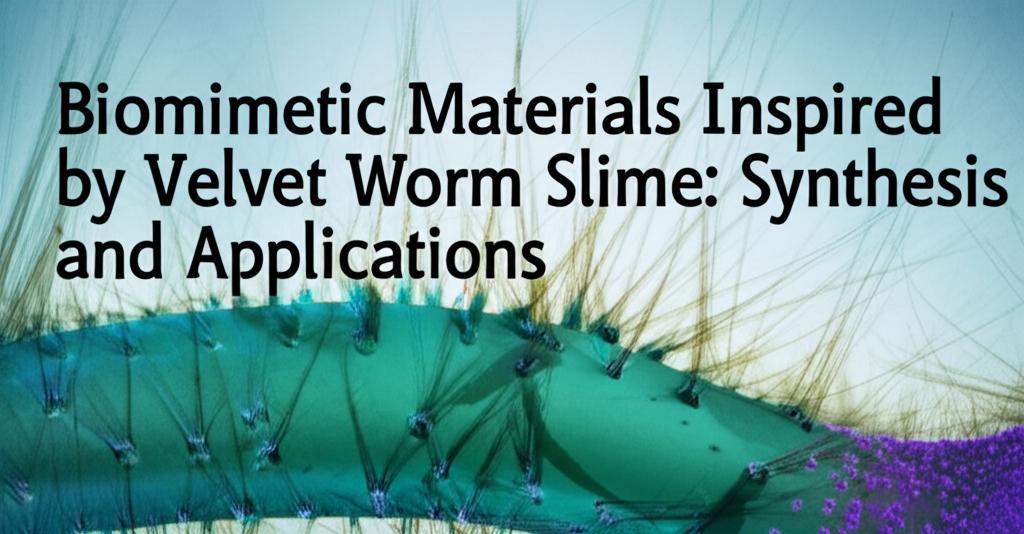Velvet worms, ancient predators of the undergrowth, possess a remarkable hunting tool: a sticky slime that they eject to immobilize their prey. This biological hydrogel has garnered significant interest in materials science due to its unique properties, leading to the development of innovative biomimetic materials.
Understanding the Natural Wonder: Velvet Worm SlimeVelvet worm slime is a complex aqueous solution primarily composed of proteins and lipids. What makes it extraordinary is its ability to transition rapidly from a liquid to a solid gel upon ejection and stretching. This rapid phase transition, coupled with its impressive adhesion and elasticity, makes it an ideal model for synthetic materials. The slime's solidification is not chemically driven but rather a physical process involving the self-assembly of protein nanoglobules into a porous, mesh-like structure as water evaporates. This process is reversible; the slime can rehydrate and liquefy.
Synthesizing Velvet Worm Slime-Inspired MaterialsResearchers are actively exploring various strategies to replicate the key features of velvet worm slime. Current approaches focus on:
- Protein-Based Hydrogels: Scientists are working with recombinant proteins that mimic the sequences and structures found in the native slime. By manipulating amino acid sequences, they aim to control the self-assembly process and the mechanical properties of the resulting hydrogels. The goal is to create materials that can undergo a similar liquid-to-solid transition under specific stimuli, such as mechanical stress or changes in solvent conditions.
- Polymer Blends and Composites: Another avenue involves creating composite materials by combining synthetic polymers with other substances that can replicate the slime's behavior. This might include incorporating nanoparticles or other functional molecules to enhance adhesion, strength, or stimuli-responsiveness. For instance, researchers are investigating polymer networks that can rapidly reorganize and stiffen when subjected to shear forces, similar to the slime's ejection process.
- Microfluidic Emulsions: Mimicking the nanoglobular structure of the slime is a key challenge. Some approaches involve using microfluidics to create stable oil-in-water or water-in-oil emulsions where the dispersed phase consists of protein-like or polymer-based nanoparticles. The controlled evaporation of the continuous phase can then lead to the self-assembly and solidification of these nanoparticles into a cohesive material.
- Controlling Reversibility and Stimuli-Response: A significant focus is on engineering reversibility into these synthetic materials, allowing them to switch between liquid and solid states multiple times, just like the natural slime. This often involves designing materials that respond to specific triggers such as pH changes, temperature fluctuations, light, or the presence of certain chemicals.
The unique properties of materials inspired by velvet worm slime open doors to a wide array of applications:
- Adhesives and Coatings: The strong, reversible adhesion of velvet worm slime makes it an excellent model for developing new types of adhesives. These could be particularly useful in biomedical applications, such as wound closure materials that can adapt to tissue movement and be easily removed without causing damage. Sprayable coatings that rapidly solidify could also find uses in protecting surfaces or delivering active compounds.
- Biomedical Engineering: The biocompatibility and tunable mechanical properties of these materials are highly attractive for medical uses. This includes developing scaffolds for tissue engineering that can support cell growth and then be resorbed or removed, drug delivery systems that can release therapeutics in a controlled manner, and soft robotics for minimally invasive surgery. The ability to transition from a liquid (injectable) to a solid gel in situ is particularly valuable.
- Soft Robotics and Actuators: Materials that can change stiffness or shape in response to stimuli are crucial for the advancement of soft robotics. Velvet worm slime-inspired materials could be used to create flexible grippers, artificial muscles, or adaptive structures that can navigate complex environments.
- Textiles and Smart Fabrics: The ability to form strong, flexible fibers from solution could lead to new types of textiles with unique properties, such as self-healing capabilities or embedded sensors.
- Food Science: The rapid gelling properties could be harnessed in the food industry, for example, in creating novel food textures or encapsulation systems for flavors and nutrients.
- Environmental Remediation: Reversibly adhesive materials could potentially be used to capture and release pollutants or to create deployable and retractable barriers for spill containment.
The field of biomimetic materials inspired by velvet worm slime is still developing, but the progress made so far is promising. As our understanding of the native slime deepens and synthetic techniques become more sophisticated, we can expect to see an increasing number of innovative materials with tailored functionalities emerge, drawing inspiration from this fascinating creature's evolutionary solution.

